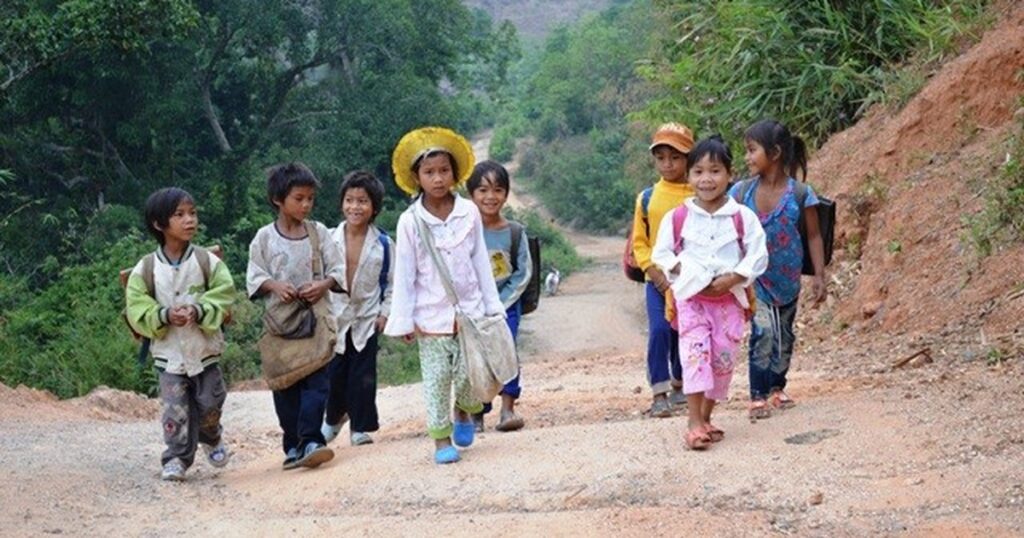Every time at the beginning of a new school year, while most children in the plains or cities have their parents and grandparents buy new books, pens, and clothes to eagerly go to school, in In remote areas, in remote villages, students begin their journey to school again with countless difficulties: long distance, danger, temporary schools, lack of facilities…
The arduous road to school
It’s not a straight road, just sit on a motorbike or car and drive for a few dozen minutes to get there, in remote areas. remote, the children’s path to school is very difficult, full of dangerous difficulties.
In many places, students have to go to school by boat, climbing passes, wading streams, crossing forests and even walking through dangerous areas or walking dozens of kilometers through zigzag, muddy, dusty, rainy dirt roads… Both male and female students had to carry their books and clothes on their heads and roll up their pants to wade across the river. Many times, books fall into the water and get wet. There are places where students have to row their own boats to cross the river.
Facilities are extremely lacking
Completely different from Spacious, solidly built schools with fully functional areas, libraries, medical rooms, playgrounds equipped with modern teaching equipment in the city; Classrooms in remote areas are deprived of all kinds of difficulties.
Funds are tight so Investment is quite limited, causing many students in remote areas to still study in classrooms made of wood and bamboo with temporary dirt floors. The dry season is hot, the rainy season is wet, the wind is blowing in all directions, which greatly affects health of students.
In addition to inadequate facilities and difficult conditions, maintaining education is a great effort, so Students in remote districts also suffer many disadvantages due to the lack of safe playgrounds for physical exercise, libraries, reading books…
Horror of toilets
The issue of toilets in schools seems like a small matter to adults, but it is a very big problem for students. In schools in remote areas and mountainous districts, this is the item that receives the least attention, leading to a situation where it is only put into use for a short time and then degrades and becomes unusable. Toilets that smell like lack of water and poor hygiene are a common situation in restrooms at schools.
The reality is that the deterioration of school toilets is having a negative impact on extremely good for students’ psychological health. According to regulations of the Ministry of Health on school hygiene, an average school of 100-200 students in a school shift must have 1 latrine. For boarding schools, an average of 25 students must have 1 toilet. However, in reality, in many places, ensuring this number is still too far away, especially in remote areas where economic conditions are still difficult.
Medical experts warn that poor quality toilets can be ideal environment for many types of diseases Contagious diseases such as respiratory disease, flu, fever, diarrhea caused by e.coli bacteria… attack young children. In addition, the fear of the toilet leads to not drinking water even when thirsty or exercising a lot to “hold back” from going to the toilet. In the long term, it can affect the child’s kidneys, urinary tract, bladder, etc.</p >
From a survey by UNICEF in Vietnam, it has been shown that only 11-7% of the total 73% of toilets in schools across the country surveyed meet safety standards. With such low standards, the concept of clean and safe toilets is becoming increasingly rare in remote areas.
Dirty toilets have a foul smell and there is no clean water in the tank. It’s full of trash and all kinds of insects and mosquitoes, which is the obsession of many students. So much so that if they are forced to go to the bathroom, many of them choose to hastily solve the problem and then rush out to escape the debt or try to wait until they get home to solve the problem. The distance children rush home from school to go to the bathroom is very dangerous because their mind only cares for one purpose: to run quickly so they can run home in time to “vent their feelings”. For children in disadvantaged areas, the road to school is bumpy with many difficulties, but the way home always brings an additional “sadness” that cannot be resolved at school because the school… does not have clean toilets. .
Join Vim to become a Toilet Warrior to rescue Vietnamese students. For every bottle of Vim purchased at Co.op Mart supermarkets nationwide from November 4 to November 26, you will contribute a bottle of Vim to improve sanitary conditions for rural students in Vietnam and at the same time receive a Tickets to participate in the “Toilet Warriors” festival for mothers and babies in Ho Chi Minh City and Hanoi. For details of the festival, please refer to: Toilet Warriors Movie
